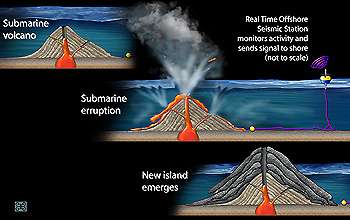Volcanic Activity Key to Oxygen-rich Atmosphere

Next time you catch a breath, be thankful, for a change, that the Earth's surface is dotted with volcanoes.
National Science Foundation-funded research published this week in the journal Nature indicates that billions of years ago, when the Earth was home largely to undersea volcanoes, some previously unknown agent was removing the gas.
The researchers suggest that mixture of gases and lavas produced by submarine volcanoes scrubbed oxygen from the atmosphere and bound it into oxygen-containing minerals.
Lee R. Kump, a professor of geosciences at Penn State University, working with a colleague at the University of Western Australia, looked at the geologic record from the Archaean--a geologic period from 3.8 to 2.5 billion years before the present day--and the Palaeoproterozoic-- geologic era immediately following that featured profound global change that included the breakup and formation of two supercontinents. They found that in the Archean there was a dearth of terrestrial volcanoes, while in the Palaeoproterozoic, although submarine volcanoes continued to be common, the population of terrestrial volcanoes increased dramatically.
"The rise of oxygen allowed for the evolution of complex oxygen-breathing life forms," Kump said.
Terrestrial volcanoes could become much more common because land masses stabilized and the current system of tectonics regime took shape.
Because submarine volcanoes erupt at lower temperatures than terrestrial volcanoes, they are more efficient at converting--or "reducing"--oxygen. As long as the reducing ability of the submarine volcanoes was larger than the amounts of oxygen created, the atmosphere had no oxygen. When terrestrial volcanoes began to dominate, oxygen levels increased.
The change over time caused an atmospheric shift from oxygen-free to oxygen-rich, the researchers argue, with profound implications for life on the planet.
Source: NSF



















